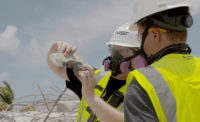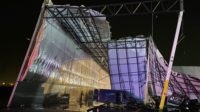The investigation into the causes of the partial collapse of the 40-year-old Champlain Towers South condominium in Surfside, Fla., nearly a year ago will soon move into its next phase: invasive testing of samples taken from the debris pile.
Investigators with the U.S. Dept. of Commerce’s National Institute of Standards and Technology have collected more than 600 pieces of physical evidence as they piece together what led to the June 24, 2021 collapse that killed 98 people, but they have so far been focused on using visible clues to determine where in the building those pieces had been located. Soon the team will begin drilling cores from concrete and cutting samples from reinforcing steel bars to test their mechanical properties and material characteristics, according to Christopher Segura, NIST investigation project leader for evidence preservation, who spoke during a presentation at the National Construction Safety Team Advisory Committee meeting June 9.
The tests will also help determine as-built structural details, and support investigators’ evaluation of the various collapse cause hypotheses being considered, Segura added. As ENR previously reported, the NIST team has developed about two-dozen hypotheses and so far ruled out none.
The team will extract hundreds of samples starting mid-July and lasting into the fall, Segura said.
Ken Hover, NIST investigation project leader for material science, said during the meeting that investigators will first use non-destructive tests to refine their sampling locations and ensure samples are intact, and also to detect any questionable regions to avoid or study further.
Physical and Chemical Analyses
Once samples have been extracted, they will undergo lab testing, Hover said. Investigators will determine concrete samples’ deformability, compression and tension characteristics, and the strength and ductility of steel samples. The samples will also be examined under a microscope for petrographic analysis so investigators can observe the materials’ characteristics and see any effects of exposure and loading, to better understand their state at the time of collapse.
While all concrete is porous, the rates and depths of penetration can vary widely, and the nature of what's penetrating the material can have varying effects, Hover said. For example, carbon dioxide penetration acidifies concrete, reducing the corrosion protection it normally offers to embedded reinforced steel. Then, penetration of water, salt and oxygen could react with the steel to produce rust. The expanding rust could crack the concrete from the inside, and reduce the bond between the concrete and steel.
Because of space constraints in the warehouse where the physical evidence is being held, NIST is planning to move the to-be-tested materials to another location. Ahead of the move, they brought in an industrial hygienist to sample the air for asbestos fibers. Preparing the materials for the move and securing them in the new location will take several weeks.
“This is an important step in the investigation, one we are able to take only after months of careful investigation and preparation,” Glenn Bell, the co-lead investigator, said in a statement.
While the investigation is ongoing, a Miami-Dade Circuit Court judge approved a $1.02-billion settlement for the victims' families June 23. And $96 million from the sale of the property will be split among those who owned units in the building.






Post a comment to this article
Report Abusive Comment